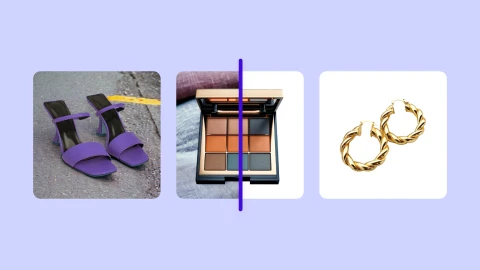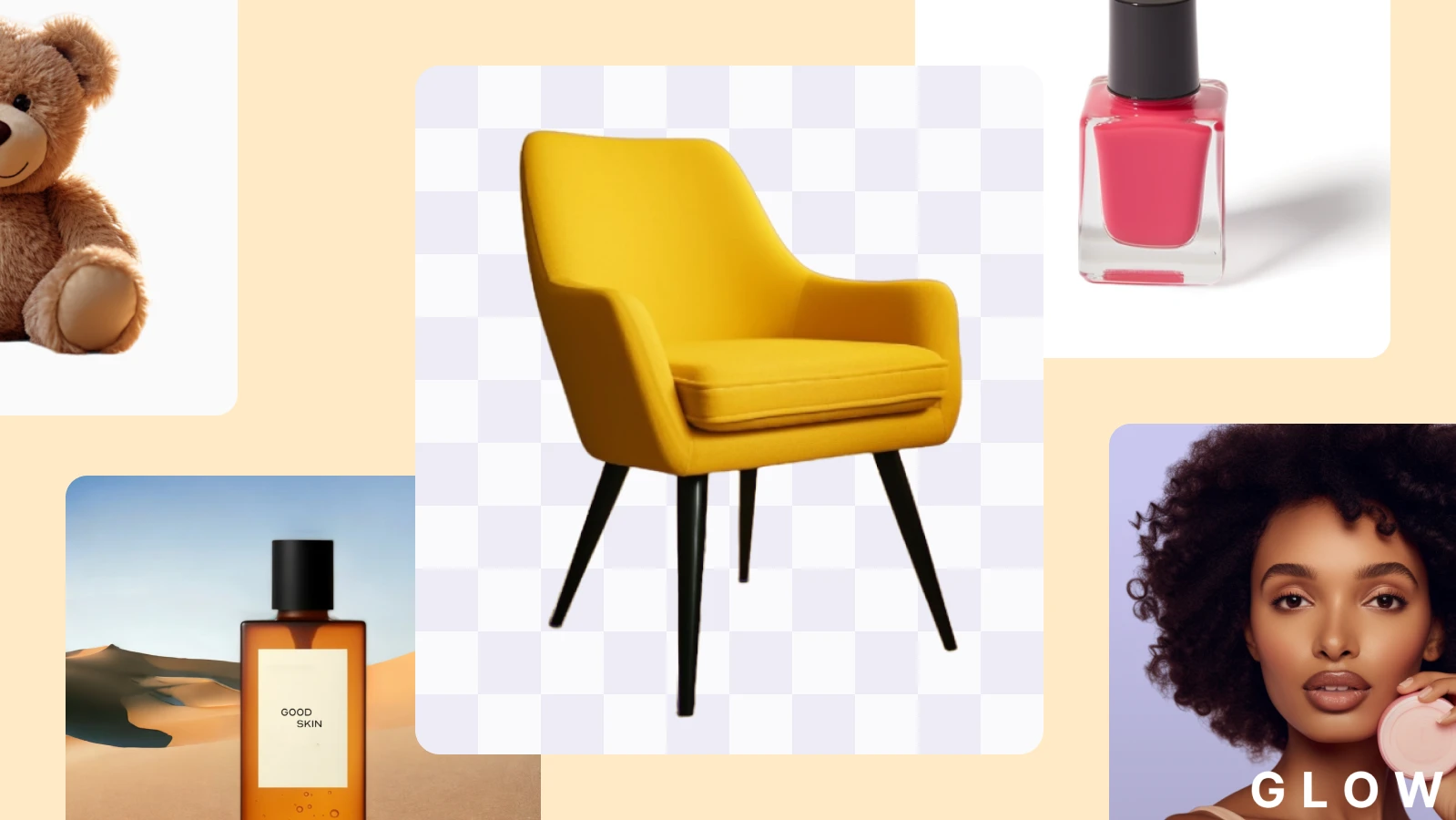50 creative AI prompts for background images


At some point in life, every business owner and content creator has scrolled through endless stock photo pages, looking for the perfect background for their product photo. With every futile search, the queries you type into Google get longer and longer because you are trying to be as specific as possible. You know what you want—but finding it? That's another story.
In the new world where artificial intelligence is our new normal, those lengthy, specific searches are called "prompts," and these prompts don't try to find you an image like your search queries; they become the image you want with Generative AI.
So basically, instead of typing into Google, you enter your requests into an AI image generator tool, and it produces an image for you. In other cases, it generates parts of your image, such as a hyper-realistic background based on your prompt.
Your final image is only as good as the information you provide, so in this article, we'll walk you through how to craft great AI prompts and share winning prompt examples for different industries, including fashion, furniture, and handmade goods, to make your imagination come alive and help you create high-quality product images.
What are AI prompts?
AI prompts are the instructions or descriptions you provide to an AI system to generate a desired result, such as text or images - by using neural networks. When you input a prompt into an AI image generator, the AI analyzes it against its trained data, looking for patterns and references that match your description. Every time something new is created, we call it generative AI.
Using AI to transform text into images wasn't so popular at first. AI art generator tools like Midjourney AI made it easier and more viral. Find here a list of the best 50 AI tools for ecommerce.
Anyone, from professional designers to hobbyists, can create complex, beautiful images by simply typing what they envision. Now, OpenAI's popular ChatGPT includes an AI image generator from text in its premium plan.
When using AI to create images, these prompts guide the AI system in the right direction. A well-crafted prompt doesn't just describe the image; it sets the mood, tone, and even the style of the artwork. Think of these prompts as a way of communicating with a highly skilled artist who doesn't speak your language but understands your words through algorithms and data patterns.
Examples of effective AI prompts to help you generate background images
Here are some examples of AI prompts that you can easily modify to help you get started with generating background images.
10 Generic AI background prompts
These creative prompts can be modified and expanded for different types of products:
A minimalist, elegant background with a soft, neutral color palette and subtle shadows, conveying a sense of sophistication and high quality.
An outdoor setting with a vibrant, natural landscape, featuring lush greenery and a clear blue sky, ideal for products related to outdoor activities or eco-friendliness.
A modern, urban environment with sleek architectural elements and a monochrome color scheme, perfect for tech or lifestyle products.
A rustic, vintage background with warm, earthy tones and textures like aged wood and weathered stone, suitable for artisanal or heritage products.
A bright, playful setting filled with pastel colors and whimsical elements like balloons or confetti, great for products targeted at children or for fun, lifestyle goods.
An artistic, abstract background with bold colors and dynamic patterns, creating a vibrant and eye-catching setting for creative or design-oriented products.
A serene, spa-like setting with elements of tranquility like smooth stones, bamboo, and a calming water feature, ideal for wellness or beauty products.
A luxurious, opulent background with rich textures and colors, gold or silver accents, and a sense of exclusivity, fitting for high-end luxury products.
A cozy, homely setting with a comfortable, inviting ambiance, featuring elements like soft lighting, plush textiles, and warm tones, suitable for home goods or comfort products.
A futuristic, sci-fi-inspired background with sleek, metallic surfaces and neon lights, offering a cutting-edge feel for innovative or tech-forward products.

10 Prompts to create background images for jewelry products
Here are 10 detailed prompts specifically tailored for creating background images for your jewelry product photos. Each of these prompts is crafted to create a unique and fitting atmosphere for various types of jewelry, enhancing their features and catering to different styles and themes which add additional details.
A minimalist, elegant background with a soft, muted color palette to accentuate the intricate details of handcrafted jewelry. The backdrop should evoke luxury and exclusivity, with a subtle texture that adds depth without distracting from the product. Ideal for highlighting the craftsmanship and quality of each piece.
A sophisticated, monochromatic background with a focus on shades of black and gray, providing a sleek and modern canvas to showcase the brilliance of diamond jewelry. The backdrop should have a glossy finish, reflecting light to enhance the sparkle of each gemstone.
An ethereal, celestial-themed setting with a dark blue and starry backdrop, perfect for accentuating the mystique of gemstone jewelry. Elements like faint constellations or a subtle lunar glow should add a touch of otherworldly elegance without overpowering the jewelry's natural beauty.
A romantic, floral-inspired background with soft pastel hues and delicate flower patterns, creating a dreamy and feminine ambiance for showcasing pearl or rose gold jewelry. The design should be subtle and graceful, evoking a sense of timeless charm.
A luxurious, velvet-textured backdrop in deep jewel tones like emerald green or sapphire blue, designed to complement the richness and opulence of gold and precious stone jewelry. The plush texture should add depth and a tactile quality to the images.
An Art Deco-inspired background with bold geometric patterns and a combination of gold, black, and ivory tones, perfect for vintage-style jewelry pieces. The backdrop should capture the glamor and sophistication of the Roaring Twenties.
A rustic, natural wood background with a raw, unpolished texture, offering a striking contrast to finely crafted silver jewelry. This backdrop should evoke artisanal charm and the handcrafted quality of each jewelry piece.
An oceanic theme with soft blues and greens, incorporating subtle wave patterns or coral motifs. This backdrop is ideal for jewelry with marine-inspired designs or pieces featuring blue gemstones like aquamarine or turquoise.
Beautifully placed on a woman’s ear lobe, with her top and hair visible in the background. Ideal for portraying earrings on a model.
A classic, timeless background with a hint of vintage luxury, featuring muted golds and antique textures. This backdrop is suitable for heirloom pieces, evoking a sense of history and legacy while highlighting the intricate details and craftsmanship of each jewelry item.

10 prompts to create background images for fashion products
Creating detailed prompts for background images tailored to fashion products involves capturing the essence of the style and mood of the clothing line. Here are 10 detailed prompts for such backgrounds:
A chic, urban streetscape with muted tones and modern architectural elements, ideal for contemporary fashion lines. The background should have a dynamic, cosmopolitan feel, emphasizing clean lines and minimalist aesthetics, suitable for showcasing sleek and sophisticated apparel.
A bohemian, natural setting with elements like wildflowers, soft earthy tones, and a sun-kissed meadow. This background is perfect for ethereal, free-spirited fashion items, emphasizing flowy fabrics and vibrant patterns.
A classic, Parisian-inspired backdrop with elements of vintage elegance, such as wrought iron balconies and quaint cobblestone streets. This setting is ideal for timeless fashion pieces, offering a blend of romance and sophistication.
A bold, graffiti-covered urban wall, conveying an edgy, street-style vibe. The backdrop should be colorful and vibrant, making it perfect for showcasing trendy, youthful fashion lines that embrace a rebellious and expressive spirit.
A minimalist, Japanese-inspired setting with clean lines, neutral colors, and elements of Zen simplicity. This backdrop is ideal for minimalistic, avant-garde fashion, emphasizing the purity of form and innovative designs.
A luxurious, high-fashion runway background with glossy floors and dramatic lighting. This setting is designed to emulate the glamor of a fashion show, perfect for haute couture and designer pieces that demand a sophisticated and stylish presentation.
An artistic, abstract background with splashes of bold colors and unconventional patterns, suitable for eclectic and artistic fashion lines. This backdrop should evoke creativity and uniqueness, complementing fashion that makes a statement.
A cozy, rustic cabin setting with warm wooden textures and a homey feel, ideal for casual, comfort-focused fashion like knitwear and loungewear. The backdrop should evoke a sense of comfort and relaxation.
A dreamy, soft-focus garden with blooming flowers and gentle sunlight, creating a romantic and whimsical setting. This background is perfect for spring collections, bridal wear, or any fashion line that embodies femininity and grace.
A sleek, futuristic setting with metallic surfaces and neon accents, creating a cutting-edge and modern vibe. This backdrop is ideal for fashion that is forward-thinking and innovative, aligning with trends that push the boundaries of traditional fashion.

10 prompts to create background images for furniture products
Background images for furniture products should set a scene that complements the furniture's style, function, and design. Products in this category include both interior and exterior decor. Here are 10 detailed prompts for your furniture products.
A modern, minimalist living room setting with clean lines, neutral colors, and ample natural light, perfect for showcasing contemporary furniture designs. The backdrop should emphasize simplicity and elegance, highlighting the furniture's sleek and sophisticated silhouette.
A cozy, rustic cabin interior with warm wood tones, a stone fireplace, and soft, ambient lighting. This setting is ideal for rustic or traditional furniture pieces, emphasizing comfort and a homely feel.
An outdoor patio scene with lush greenery, flowering plants, and a serene garden ambiance. This backdrop is perfect for garden or patio furniture, creating an inviting outdoor living space that showcases the furniture's durability and style.
An industrial loft space with exposed brick walls, high ceilings, and metallic accents. This setting suits industrial-style furniture, highlighting its raw, edgy aesthetics and robust materials.
A luxurious, opulent living room with rich textures, elegant draperies, and sophisticated decor. Ideal for high-end, luxury furniture pieces, this backdrop should exude a sense of grandeur and refinement.
A bright, airy Scandinavian-style interior with white walls, light wood floors, and minimal decor. Perfect for showcasing Scandinavian or mid-century modern furniture, emphasizing functionality and a clean aesthetic.
An artistic studio space with large windows, abstract art on the walls, and a creative, eclectic vibe. This setting is great for bohemian or unique, handcrafted furniture pieces, highlighting their artistic and unconventional design.
A classic, traditional study with rich wooden paneling, a grand bookcase, and a vintage world map. This backdrop is suitable for classic, timeless furniture pieces, evoking a sense of heritage and sophistication.
A contemporary, high-tech home office with sleek gadgets, modern art, and a dynamic, functional layout. Ideal for modern office furniture, this backdrop should emphasize the furniture's ergonomic design and adaptability.
A tranquil, Zen-inspired bedroom with soft, muted colors, simple decor, and a peaceful, balanced ambiance. This setting is perfect for minimalist bedroom furniture, highlighting its serene and uncluttered design.

BONUS: 10 prompts to create background images for handmade/home-made goods
We created a special section for “artisanal” products ranging from skincare products to baked goods. It is a wide spectrum for every business owner that makes and sells products like jams, soaps, candles, etc. These prompts focus on themes that emphasize handcrafted quality, natural ingredients, and the unique charm of small-scale production.
A rustic, natural setting with elements like raw wood, burlap, and greenery, highlighting the handmade and organic nature of artisanal skincare products. The backdrop should convey a sense of earthiness and purity, reflecting the natural ingredients used.
A cozy, home-kitchen scene with warm lighting and vintage cookware, perfect for showcasing homemade baked goods. The backdrop should evoke feelings of warmth and comfort, reminiscent of traditional baking.
An elegant, minimalist shelf with soft, neutral tones and delicate ceramic or glass containers. This backdrop is ideal for presenting artisanal beauty products, emphasizing simplicity, quality, and understated luxury.
A vibrant, farmer's market set up with fresh produce, flowers, and hand-lettered signage. This setting suits a range of artisanal food products, emphasizing freshness, quality, and community-based production.
A traditional, old-world workshop with tools and raw materials visible, ideal for handcrafted goods like soaps or candles. The backdrop should tell the story of craftsmanship and the attention to detail in each product.
An outdoor, garden setting with natural light and a focus on lush plants and flowers. This background is perfect for herbal skincare products, connecting the product to its botanical origins.
A quaint, country-style pantry with wooden shelves, jars of preserves, and handmade pottery. This backdrop is suitable for artisanal food items like jams, sauces, or jars of honey, emphasizing homestyle quality and tradition.
A chic, boutique-like setting with elegant displays and sophisticated decor, ideal for showcasing high-end, artisanal products like specialty chocolates or gourmet cheeses. The backdrop should convey exclusivity and luxury.
A creative, art studio ambiance with splashes of paint and artistic tools, suitable for uniquely designed artisanal products like hand-painted ceramics or custom jewelry. The backdrop should reflect creativity and one-of-a-kind designs.
A serene, spa-like environment with elements like pebbles, bamboo, and softly flickering candles. This setting is perfect for artisanal wellness products, emphasizing tranquility, balance, and self-care.

How to write a good AI prompt
Creating the perfect AI prompt is an art form in itself. You have to balance between descriptive prompts which are enough to guide the AI image generator and leaving room for creative interpretation.
A well-crafted prompt has the following features:
Clarity: Clarity in your prompts ensures that the AI understands exactly what you are looking for. This means being specific about the elements you want in your image, such as the type of objects, the setting, or the main focus. However, it’s important to strike a balance – too much detail can be limiting, while too little can lead to unpredictable results.
Descriptiveness: Using descriptive language in your prompts gives the AI a richer palette to work from. Describe not just the objects but also the mood, the lighting, the style, and even the textures and aspect ratio.
Creativity: One of the most exciting aspects of AI-generated art is its ability to interpret and realize creative, whimsical ideas. Don't shy away from proposing unconventional or imaginative concepts. This creative freedom is what sets AI art apart from traditional stock images, providing a unique opportunity to stand out.
Open-endedness: While details are important, there's a fine line between being descriptive and being overly prescriptive. If a prompt is too restrictive, it can limit the AI’s creative potential, leading to images that feel forced or unnatural. On the other hand, a prompt that’s too open-ended might result in something far from your desired outcome.
How to write good AI prompts for product background images
An AI-generated background tailored to complement your product can enhance its appeal and convey the right message to your audience. Here's how to craft effective prompts that result in perfect backgrounds for your product photos:
Provide specific product context
AI image generators are not humans; they don't see the world and objects like we do. They interpret textual prompts literally and lack the intuitive understanding that humans have.
Therefore, the first step in crafting an AI prompt for product background images is to specify the product, its intended use, and its emotional appeal. For example, if you are trying to create background images for a luxury watch, using terms like “elegance,” “sophistication,” or “prestige” can guide the AI to generate backgrounds that embody these qualities.
Describe your product style
The words used in your AI prompt should reflect your product's essence. Think of personality traits you would assign to your product. Is it fun, whimsical, and vibrant, or is it sophisticated, minimalist, and modern? The answer to this will dictate your choice of words.
For instance, for a playful product, you might use words like 'lively', 'colorful', 'vibrant colors', 'dark tones', 'bright colors' or 'whimsical,' whereas, for a sophisticated product, you might opt for 'elegant,' classy,' or 'refined.'
You can also consider the emotions you want to evoke in your audience when they see your product. Words that evoke happiness, comfort, excitement, or trust can guide the AI to create backgrounds that resonate emotionally with your audience.
📚 Further reading: Learn how to create AI backgrounds using an image for reference with our article about image prompting for beginners.
Add contextual elements
Contextual elements are key to placing your product in an environment that enhances its appeal and connects with your target audience. Think about where your product would ideally be used or enjoyed. This helps the AI image generator to create a setting that speaks directly to the intended use and audience of the product.
For example, for outdoor gear, you might picture a mountainous landscape or a forest scene, while sandy shores and blue skies can create an inviting backdrop for a beachwear line.
Also, consider the lifestyle your product fits into. A background with opulent settings or high-end ambiance can be effective for luxury items. For products like hiking boots or camping equipment, use backgrounds that show rugged landscapes, mountain ranges, or forest trails. These settings resonate with the adventurous spirit of the target audience and the product's intended use.
Add texture details
The texture of the background in product images can significantly influence how the target audience perceives and receives the product. It can convey the quality and nature of the product. For instance, a product made from natural materials might be best presented against a matte, earthy texture, emphasizing its organic origins. Including the expected lighting styles (cinematic lighting, natural lighting) can also help to create the desired image.
It's great to use textures in the background that mirror or complement the product's qualities. If your product has a rugged, durable feel, a background with similar textures can reinforce this attribute.
But sometimes, contrasting the product's texture with the background can make the product stand out more. For instance, a sleek, modern gadget against a rustic wooden backdrop can create a striking contrast that draws the eye.
Align your brand’s aesthetic
Consistency in visual branding is critical to establishing a solid brand identity. The background of your product images should align with your brand's overall aesthetic, including color schemes, values, and themes.
If your brand uses specific colors in its branding, include these in your prompt. This ensures that the backgrounds will be consistent with your brand's color palette, enhancing brand recognition and cohesiveness.
You should also use backgrounds that reflect your brand's values. For example, if sustainability is a core value, backgrounds with natural elements or themes of eco-friendliness can reinforce this message.
You may also like to read: 14 product photography ideas to boost online sales
How to use prompts in Photoroom’s AI image generator
When you're using Photoroom’s Instant Backgrounds to jazz up your product photos, you can direct the AI behind our technology using the Custom Prompts feature. This feature allows you to describe and create a more specific AI-generated background for your product photos. It is accessible in the mobile and web app.
To access the Custom Prompts feature, open Photoroom and select “AI Backgrounds” from the Create page. Once you upload an image, you can customize prompts by clicking the pencil icon or "Create a background" at the top right corner of your screen.
 There are three ways to use custom prompts in Photoroom:
There are three ways to use custom prompts in Photoroom:
Assisted prompts: As implied, Photoroom assists you in writing prompts for your image. It provides a form-like structure for you to follow so you can fill in simple words like where you want your product to be (e.g., on a table) and the things you want in the background.
Manual prompts: With manual prompts, the world is your oyster. Follow the tips we shared earlier to craft detailed prompts or you can modify any of the prompts above. There is an optional "negative prompts" tab to fill out anything you don't want in your image. For example, if you want a beach sand scene, you can put "water" in the negative prompts tab so the AI knows to focus just on the sand.
Image prompts: This feature allows the AI image generator to create a background based on an image. It is available in the Photoroom web and iOS apps. You can upload the picture you want to guide the AI with or search for one in Unsplash directly from the app, and the AI will generate an image inspired by your image prompt.

For more detailed information on how to use each of these custom prompt features, here's a detailed guide to help you.
FAQs about AI prompts
Is there a free AI image generator?
Yes, there are several free AI image generators who use generative AI, available online which allow users to create AI-generated images with certain limitations or features based on the free plan.
What is a good prompt for AI backgrounds?
A good prompt for AI backgrounds should be clear, descriptive, and imaginative, specifying elements like the mood, style, color scheme, and key features relevant to what you want to portray in the background.
How can I create my own AI images?
You can create your own AI images by using AI image generation tools or platforms, where you input a detailed text prompt and the AI software generates ai generated content based on your specifications.
Which art styles can I use for prompting?
There are several art styles that you can use for prompting, depending on your preferences and the message you want to convey. Some popular art styles for prompting include realistic, abstract style, pop art, minimalism, impressionism, surrealism, style of cubism, watercolor painting, comic book style and collage.
Are there prompt generators?
You can use tools like ChatGPT to help you create descriptive prompts if if is difficult to create your own effective prompts. ChatGPT prompts can help you to achieve to create the art style (classic style or artistic style) that you are looking for.
Related articles:















